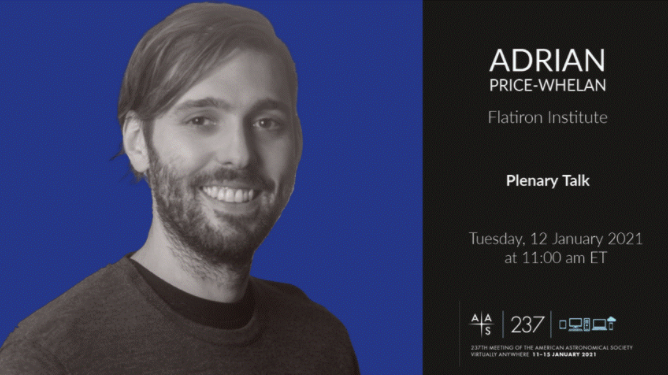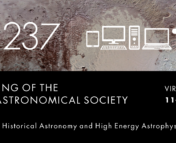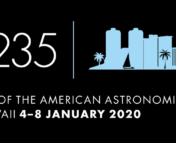In this series of posts, we sit down with a few of the keynote speakers of the 237th AAS meeting to learn more about them and their research. You can see a full schedule of their talks here, and read our other interviews here!

Have you ever thought about how the Milky Way came to be? Our galaxy is billions of years old, so unfortunately astronomers can’t directly observe many of the mechanisms responsible for creating or evolving our galaxy. However, new data from Gaia and other sources have provided incredible pictures of the ways bodies in the Milky Way are moving now, allowing researchers to use their velocity signatures as “fossils” of major dynamical events in our galaxy’s history. Such data is revolutionary for Dr. Adrian Price-Whelan, a postdoc at the Center for Computational Astrophysics in New York City. Working at the forefront of research into the dynamical history of the Milky Way and what it teaches us about the distribution of matter (both dark and normal) throughout our galaxy, Price-Whelan believes we are in a transformative era for understanding our galaxy. Be sure to check out his plenary talk at #AAS237 to discover why, but read on to get a sneak peek and find out more about Adrian!
Finding Your Equilibrium
Astronomy wasn’t always in Price-Whelan’s orbit. His original plan was to pursue sound design for theater and live music as an undergraduate at NYU. He experimented with taking intro science and math courses, though, and experiences with two excellent professors – one in physics and one in calculus – convinced him he could pursue astronomy. Building on his programming experience from high school, Price-Whelan started working with David Hogg and tinkering around with what a programming language called Python could mean for astronomy. From there, he got more experience working at the intersection of sophisticated programming and research.
“It was a race to do the four-year physics degree in three years” after switching his major, says Price-Whelan. “After that, I realized I couldn’t go straight into anything. So I took a year and I worked for Mike [Blanton] and the SDSS doing software development.” He maintained this interest in programming throughout his Ph.D. with Kathryn Johnston at Columbia, and this has led him to work that doesn’t fit squarely in theory or observation. “I think, for me, it’s at the interface. It’s knowing enough about the engineering aspects to really understand the data, but also knowing enough about the theory to be able to make some headway by connecting the two,” he says.
(Dark Matter) Islands in the (Stellar) Stream
Using his expertise in theory, observation, and statistical inference, Price-Whelan has worked extensively to understand the nature of dark matter on small scales (i.e. think scales smaller than a dwarf galaxy). Stellar streams, or large collections of co-moving stars, are a primary tool that astronomers, including Price-Whelan, have been using to constrain dark matter on these scales. Such streams were originally star clusters or dwarf galaxies, but they now have been stretched out by tidal forces or other gravitational interactions in the galaxy. Dark matter subhalos, or small clumps of dark matter dispersed throughout a larger dark matter halo, are one of the major drivers of stellar stream evolution.
Consequently, by studying the positions and velocities of stars in these streams, astronomers can learn a lot about dark matter subhalos that may be lurking in the vicinity. According to Price-Whelan, “Streams are basically the only method we know of to find or study these low-mass subhalos, so they are especially valuable!” The Gaia satellite has been particularly transformative in discovering these streams, delivering astronomers extremely precise positions, distances, motions of over a billion stars. Thanks to Gaia, Price-Whelan says that “within the next few years, we will probably produce constraints on the subhalo mass function below 107 solar masses or so.” He is also particularly excited about future observatories, like the Vera C. Rubin Observatory in Chile and the Nancy Grace Roman Space Telescope. “With Rubin, we’re all of sudden going to be able to see these streams and resolved stars around, by the end of the survey, millions of galaxies,” he says.
Making Science Accessible
Developing open-source code has also been a major aspect of Price-Whelan’s career. He is a core contributor to the Astropy package, developer of a variety of packages such as Gala and pyia (packages for galactic and gravitational dynamics and working with Gaia data, respectively), and contributor to a number of others. When asked what advice he might give to young astronomers who want to write their own packages, he says, “I would advocate that people put their code on GitHub, share their code even if you don’t package it. If you package it, great! But even if you don’t package it…it is better to have that code there, even if you don’t make it accessible at all, than for it to not be there and open for other people to see.” Check out this Astrobite for other good coding practices.
Mentorship is also crucial for Price-Whelan. He believes that open and shared mentorship is the best way to get solid advice for a successful career. “Find a set of mentors that cover all of the things that you need. Don’t look for any individual mentor to do it all,” he says. “You should have mentors that are your friends, you should have mentors that are giving you career advice, mentors that are giving you life advice, mentors that are reading and writing in the papers you are writing. I think it’s important to not rely on any individual person for all of those things. It’s okay to have multiple people fill those roles.”
On the other hand, he also believes it is very important for mentors to seek out training to ensure they are well-prepared to offer effective advice to their mentees. “[Mentorship] is the most important thing that we do,” Price-Whelan says. “And none of us have any idea how to do it and we’re all trying to piece it together based on our experiences…trying to pass along the good parts, but we also pass on a lot of unconscious bias and bias that has come to us from our mentors. If we don’t realize that and recognize it, then we’re never going to make our field more comfortable for people who don’t share the experiences that our mentors shared.” For Price-Whelan, seeking to improve our understanding of dynamics, both galactic and social, will help to define this new era in astronomy.
Come check out Dr. Price-Whelan’s talk, “A New Era for Galactic Dynamics in the Milky Way”, on Tuesday, January 12th at 11:00 AM ET at #AAS237!

Astrobite edited by: Briley Lewis
Featured image credit: American Astronomical Society



